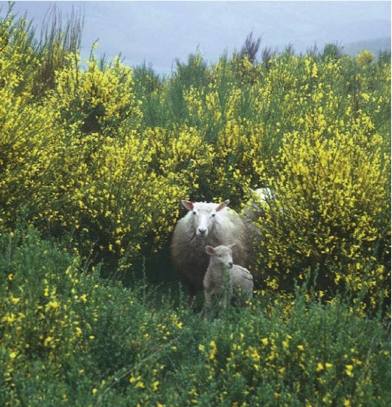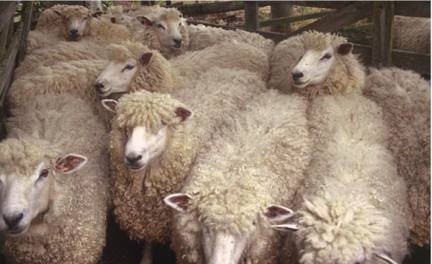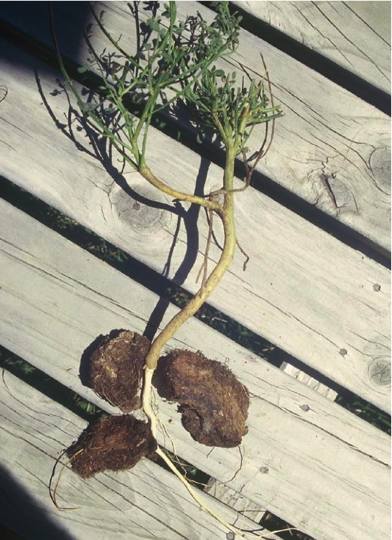Broom and gorse - are we as awake as we should be?
Nick Ledgard, New Zealand Tree Grower May 2005.
This article is a departure from the normal tree topics, but it involves a couple of woody plants with which most of us are equally familiar - namely broom Cytisus scoparius and gorse Ulex europaeus.
Apart from pheasants and quail, all of which have limited distributions, I felt that birds were unlikely vectors. If they were the major players that was commonly believed, surely there would be many more outlier occurrences than there actually are. Also, there would be significantly more seedlings appearing under bird congregating areas such as roosting sites, as there is for other bird-spread woody species such as elderberry, rowan and blackberry.
Culprit discovered
So, what was responsible for these common and supposedly "bird-spread" gorse and broom occurrences? It did not take me long to figure out that the most likely vectors had to be other animals, and I was soon observing plenty of circumstantial evidence that sheep were probably the main culprits. Pioneer farmers used to sprinkle grass seed on to sheep's backs to aid the spread of pasture plants on recently broken-in land.
As for the likes of broom spread, I could imagine and have since witnessed sheep resting on a hot January day under valley-bottom broom bushes as pods fling seed out and down on to their backs, just before being moved up on to the hills as the low country feed dries off. On the summer country, seed is shaken free, often at ridge top camp sites, from where gravity can readily assist its movement downwards. I have since spoken to quite a few farmers who knew of this seed dissemination pathway, but I know of many more who were not aware of its significance.
Sheep seed trial
 Back at home I decided to do some investigations of my own. I borrowed three seed trays from work and set them up under a patch of mature, two-metre high broom. From Christmas 2000 until mid-February 2001, one of the family collected the tray catch at the end of each day. Seed was sieved out and counted, and mean numbers and weights per day and per hectare calculated.
Back at home I decided to do some investigations of my own. I borrowed three seed trays from work and set them up under a patch of mature, two-metre high broom. From Christmas 2000 until mid-February 2001, one of the family collected the tray catch at the end of each day. Seed was sieved out and counted, and mean numbers and weights per day and per hectare calculated.
The end result was a total of 5,646 seeds collected over a period of seven weeks. This equated to 139 million seeds per hectare, which at an average weight of 0.9 g per 100 seeds, makes a total of 1.25 tonnes of seed per hectare. Seed dissemination from the pods and into the trays was greatest on the warmest days. The highest seed falls were on January 16, 21 and 23 respectively, which coincided with periods of high daily maximum temperature, when most of the seed pods were black and exploding readily.
Seeding the fleeces
Next, I sorted the seed into 20 lots of 100, and sprinkled each lot by hand along the backs of 20 of my English Leicester ewes with full fleeces. The sheep were then released for normal grazing, where there was no possibility of picking up extra broom seed. With the aid of a shearing mate, groups of five sheep were shorn after one, two, three and five weeks. All shearing was carried out on a plastic sheet to catch any seed which might be dislodged during shearing. Each fleece was bagged separately, together with all off-cuts and debris which had accumulated on the sheet. Finally, every fleece was carefully inspected, and seed counted – mostly by my wife, Biddy, as she proved to be much more expert than I at seed detection.

A closer look
About 10 years ago, a combination of a long time involvement with ornithology, and a research programme on the spread of introduced conifers, prompted me to start taking a closer look at the spread of broom and gorse. At that time, I imagined that we would know plenty about how the seed of these two species is disseminated - after all, they are our commonest woody weeds. But as I soon discovered there was a large gap in our knowledge, together with surprisingly poor awareness about some of the key dispersal pathways. And what was worse, I realised that without such knowledge, spread was still continuing unabated in many areas of the country.
Incomplete knowledge
Most people are familiar with gorse and broom's explosive pods which scatter seeds a few metres at most. And they are aware of longer distance dispersal by machinery - seed carried in mud on bulldozer tracks, and in loads of gravel transported by trucks and by water in streams and rivers.
These spread mechanisms explain the arrival of many gorse and broom infestations, but certainly not all. They do not explain the many lone outliers and clumps frequently seen on slopes well away from tracks and waterways. When I started asking farmers how the seed for these had arrived in the first place, the commonest answer I got was birds. That was when I realised that our knowledge was incomplete, and where my ornithological background became useful, for I had neither observed nor read of New Zealand cases where birds had spread gorse and broom seed.

Carried for some time
As expected, seed numbers in the fleeces declined quite rapidly initially, and then more slowly over time. The average number per individual fleece after one, two, three and five weeks was 28, 24, 13 and 23 respectively. In addition to broom seed, seeds of silver wattle Acacia dealbata and tree lucerne Chamaecytisus palmensis were found in the fleeces. None of these had been seeded by hand, but both are present on our land.
This small hobby trial demonstrated to me that considerable quantities of broom seed can be produced by mature broom plants, and that the seed is capable of being carried by sheep for a number of weeks. Close inspection of fleeces revealed some seed to be well enmeshed in the wool, to the extent that it was likely to be carried for much more than five weeks. For convenience sake, the figure of 100 seeds was chosen for the seeding of individual sheep. However, it would be very possible for more seed to fall on to a sheep's back.
The seed trays showed that there were three hot days when over 1,700 seeds per square metre were recorded. With the average sheep back covering an area of around 0.15 square metres, it would be possible for one sheep to have at least 250 seeds land on it in a single day. My conclusion is that it is very likely that sheep have been actively disseminating broom and gorse seed in New Zealand by the above means for a long time, and that in many areas such a dispersal process continues to this day.
Not just sheep
Sheep may be the major animal dispersing broom and gorse seed, but they are not the only one. Any animal can carry seed in mud attached to feet or their body, but the distances carried would tend to be small. Pigs are also likely seed vectors. Since 2000 I have inspected the guts and faeces of a few wild pigs and found broom seed in some. More study is needed to determine if pigs are a significant seed carrier. One farmer friend is adamant that possums can spread broom seed, as he has observed a greater incidence of seedlings alongside possum trails - but this is the only instance that I know which involves these animals.
I have also helped a student undertake a trial with quail, as a study in Kaingaroa in 1989 showed that these birds eat large quantities of broom seed during the autumn and winter. The student fed broom seed to captive quail and concluded that very little, if any, broom seed is likely to pass intact through wild quail, and that "quail are a theoretically possible, but very unimportant disperser, of broom seed in New Zealand". As far as I can see, one thing is for sure. They and any other bird or animal, are unlikely to be as important as sheep.
The solution
The solution to stopping the spread of broom and gorse seed by sheep is to be aware of broom and gorse seeding relative to sheep movement. Between December and March sheep should not be shifted from areas where these species are seeding to uninfested paddocks unless the sheep are shorn first.

 Farm Forestry New Zealand
Farm Forestry New Zealand

